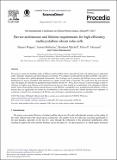Device Architecture and Lifetime Requirements for High Efficiency Multicrystalline Silicon Solar Cells
Author(s)
Mitchell, Bernhard; Altermatt, Pietro P.; Wagner, Hannes; Hofstetter, Jasmin; Buonassisi, Anthony
DownloadDevice Architecture.pdf (331.2Kb)
PUBLISHER_CC
Publisher with Creative Commons License
Creative Commons Attribution
Terms of use
Metadata
Show full item recordAbstract
We present a numerical simulation study of different multicrystalline silicon materials and solar cell architectures to understand today's efficiency limitations and future efficiency possibilities. We compare conventional full-area BSF and PERC solar cells to future cell designs with a gallium phosphide heteroemitter. For all designs, mc-Si materials with different excess carrier lifetime distributions are used as simulation input parameters to capture a broad range of materials. The results show that conventional solar cell designs are sufficient for generalized mean lifetimes between 40 – 90 μs, but do not give a clear advantage in terms of efficiency for higher mean lifetime mc-Si material because they are often limited by recombination in the phosphorus diffused emitter region. Heteroemitter designs instead increase in cell efficiency considerable up to generalized mean lifetimes of 380 μs because they are significantly less limited by recombination in the emitter and the bulk lifetime becomes more important. In conclusion, to benefit from increasing mc-Si lifetime, new cell designs, especially heteroemitter, are desirable.
Date issued
2015-08Department
Massachusetts Institute of Technology. Department of Mechanical EngineeringJournal
Energy Procedia
Publisher
Elsevier
Citation
Wagner, Hannes et al. “Device Architecture and Lifetime Requirements for High Efficiency Multicrystalline Silicon Solar Cells.” Energy Procedia 77 (2015): 225–230.
Version: Final published version
ISSN
1876-6102